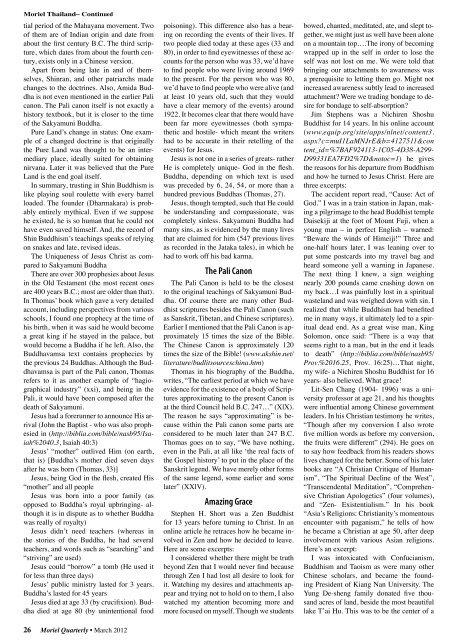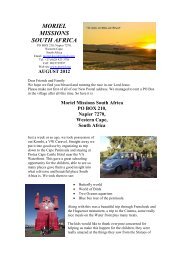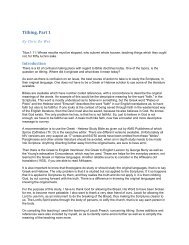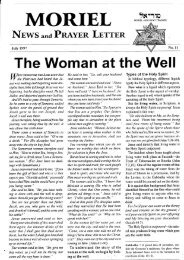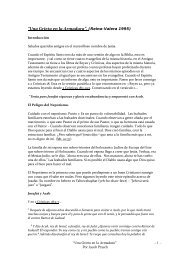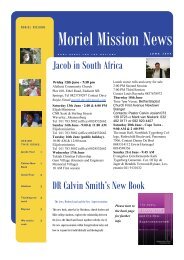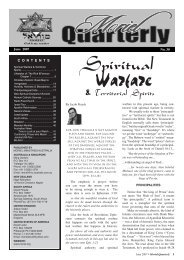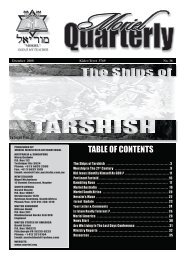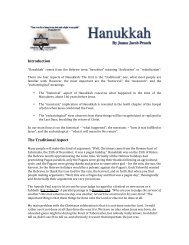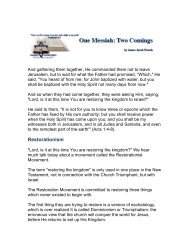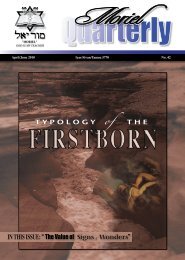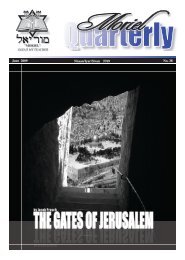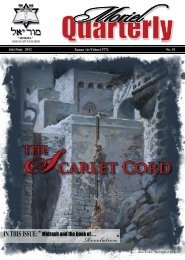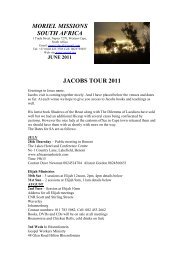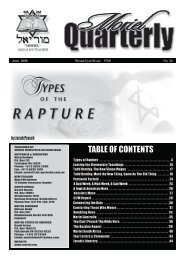The Legacy of Jacob - Moriel Ministries
The Legacy of Jacob - Moriel Ministries
The Legacy of Jacob - Moriel Ministries
You also want an ePaper? Increase the reach of your titles
YUMPU automatically turns print PDFs into web optimized ePapers that Google loves.
<strong>Moriel</strong> Thailand– Continued<br />
tial period <strong>of</strong> the Mahayana movement. Two<br />
<strong>of</strong> them are <strong>of</strong> Indian origin and date from<br />
about the first century B.C. <strong>The</strong> third scripture,<br />
which dates from about the fourth century,<br />
exists only in a Chinese version.<br />
Apart from being late in and <strong>of</strong> themselves,<br />
Shinran, and other patriarchs made<br />
changes to the doctrines. Also, Amida Buddha<br />
is not even mentioned in the earlier Pali<br />
canon. <strong>The</strong> Pali canon itself is not exactly a<br />
history textbook, but it is closer to the time<br />
<strong>of</strong> the Sakyamuni Buddha.<br />
Pure Land’s change in status: One example<br />
<strong>of</strong> a changed doctrine is that originally<br />
the Pure Land was thought to be an intermediary<br />
place, ideally suited for obtaining<br />
nirvana. Later it was believed that the Pure<br />
Land is the end goal itself.<br />
In summary, trusting in Shin Buddhism is<br />
like playing soul roulette with every barrel<br />
loaded. <strong>The</strong> founder (Dharmakara) is probably<br />
entirely mythical. Even if we suppose<br />
he existed, he is so human that he could not<br />
have even saved himself. And, the record <strong>of</strong><br />
Shin Buddhism’s teachings speaks <strong>of</strong> relying<br />
on snakes and late, revised ideas.<br />
<strong>The</strong> Uniqueness <strong>of</strong> Jesus Christ as compared<br />
to Sakyamuni Buddha<br />
<strong>The</strong>re are over 300 prophesies about Jesus<br />
in the Old Testament (the most recent ones<br />
are 400 years B.C.; most are older than that).<br />
In Thomas’ book which gave a very detailed<br />
account, including perspectives from various<br />
schools, I found one prophecy at the time <strong>of</strong><br />
his birth, when it was said he would become<br />
a great king if he stayed in the palace, but<br />
would become a Buddha if he left. Also, the<br />
Buddhavamsa text contains prophecies by<br />
the previous 24 Buddhas. Although the Buddhavamsa<br />
is part <strong>of</strong> the Pali canon, Thomas<br />
refers to it as another example <strong>of</strong> “hagiographical<br />
industry” (xxi), and being in the<br />
Pali, it would have been composed after the<br />
death <strong>of</strong> Sakyamuni.<br />
Jesus had a forerunner to announce His arrival<br />
(John the Baptist - who was also prophesied<br />
in (http://biblia.com/bible/nasb95/Isaiah%2040.3,<br />
Isaiah 40:3)<br />
Jesus’ “mother” outlived Him (on earth,<br />
that is) [Buddha’s mother died seven days<br />
after he was born (Thomas, 33)]<br />
Jesus, being God in the flesh, created His<br />
“mother” and all people<br />
Jesus was born into a poor family (as<br />
opposed to Buddha’s royal upbringing- although<br />
it is in dispute as to whether Buddha<br />
was really <strong>of</strong> royalty)<br />
Jesus didn’t need teachers (whereas in<br />
the stories <strong>of</strong> the Buddha, he had several<br />
teachers, and words such as “searching” and<br />
“striving” are used)<br />
Jesus could “borrow” a tomb (He used it<br />
for less than three days)<br />
Jesus’ public ministry lasted for 3 years.<br />
Buddha’s lasted for 45 years<br />
Jesus died at age 33 (by crucifixion). Buddha<br />
died at age 80 (by unintentional food<br />
poisoning). This difference also has a bearing<br />
on recording the events <strong>of</strong> their lives. If<br />
two people died today at these ages (33 and<br />
80), in order to find eyewitnesses <strong>of</strong> these accounts<br />
for the person who was 33, we’d have<br />
to find people who were living around 1969<br />
to the present. For the person who was 80,<br />
we’d have to find people who were alive (and<br />
at least 10 years old, such that they would<br />
have a clear memory <strong>of</strong> the events) around<br />
1922. It becomes clear that there would have<br />
been far more eyewitnesses (both sympathetic<br />
and hostile- which meant the writers<br />
had to be accurate in their retelling <strong>of</strong> the<br />
events) for Jesus.<br />
Jesus is not one in a series <strong>of</strong> greats- rather<br />
He is completely unique- God in the flesh.<br />
Buddha, depending on which text is used<br />
was preceded by 6, 24, 54, or more than a<br />
hundred previous Buddhas (Thomas, 27).<br />
Jesus, though tempted, such that He could<br />
be understanding and compassionate, was<br />
completely sinless. Sakyamuni Buddha had<br />
many sins, as is evidenced by the many lives<br />
that are claimed for him (547 previous lives<br />
as recorded in the Jataka tales), in which he<br />
had to work <strong>of</strong>f his bad karma.<br />
<strong>The</strong> Pali Canon<br />
<strong>The</strong> Pali Canon is held to be the closest<br />
to the original teachings <strong>of</strong> Sakyamuni Buddha.<br />
Of course there are many other Buddhist<br />
scriptures besides the Pali Canon (such<br />
as Sanskrit, Tibetan, and Chinese scriptures).<br />
Earlier I mentioned that the Pali Canon is approximately<br />
15 times the size <strong>of</strong> the Bible.<br />
<strong>The</strong> Chinese Canon is approximately 120<br />
times the size <strong>of</strong> the Bible! (www.akshin.net/<br />
literature/budlitsourceschina.htm)<br />
Thomas in his biography <strong>of</strong> the Buddha,<br />
writes, “<strong>The</strong> earliest period at which we have<br />
evidence for the existence <strong>of</strong> a body <strong>of</strong> Scriptures<br />
approximating to the present Canon is<br />
at the third Council held B.C. 247…” (XlX).<br />
<strong>The</strong> reason he says “approximating” is because<br />
within the Pali canon some parts are<br />
considered to be much later than 247 B.C.<br />
Thomas goes on to say, “We have nothing,<br />
even in the Pali, at all like ‘the real facts <strong>of</strong><br />
the Gospel history’ to put in the place <strong>of</strong> the<br />
Sanskrit legend. We have merely other forms<br />
<strong>of</strong> the same legend, some earlier and some<br />
later” (XXlV).<br />
Amazing Grace<br />
Stephen H. Short was a Zen Buddhist<br />
for 13 years before turning to Christ. In an<br />
online article he retraces how he became involved<br />
in Zen and how he decided to leave.<br />
Here are some excerpts:<br />
I considered whether there might be truth<br />
beyond Zen that I would never find because<br />
through Zen I had lost all desire to look for<br />
it. Watching my desires and attachments appear<br />
and trying not to hold on to them, I also<br />
watched my attention becoming more and<br />
more focused on myself. Though we students<br />
bowed, chanted, meditated, ate, and slept together,<br />
we might just as well have been alone<br />
on a mountain top….<strong>The</strong> irony <strong>of</strong> becoming<br />
wrapped up in the self in order to lose the<br />
self was not lost on me. We were told that<br />
bringing our attachments to awareness was<br />
a prerequisite to letting them go. Might not<br />
increased awareness subtly lead to increased<br />
attachment Were we trading bondage to desire<br />
for bondage to self-absorption<br />
Jim Stephens was a Nichiren Shoshu<br />
Buddhist for 14 years. In his online account<br />
(www.equip.org/site/apps/nlnet/content3.<br />
aspxc=muI1LaMNJrE&b=4127511&con<br />
tent_id=%7BAF924113-1C05-4D38-A299-<br />
D99331EA7FD2%7D¬oc=1) he gives<br />
the reasons for his departure from Buddhism<br />
and how he turned to Jesus Christ. Here are<br />
three excerpts:<br />
<strong>The</strong> accident report read, “Cause: Act <strong>of</strong><br />
God.” I was in a train station in Japan, making<br />
a pilgrimage to the head Buddhist temple<br />
Daisekiji at the foot <strong>of</strong> Mount Fuji, when a<br />
young man – in perfect English – warned:<br />
“Beware the winds <strong>of</strong> Himeiji!” Three and<br />
one-half hours later, I was leaning over to<br />
put some postcards into my travel bag and<br />
heard someone yell a warning in Japanese.<br />
<strong>The</strong> next thing I knew, a sign weighing<br />
nearly 200 pounds came crashing down on<br />
my back…I was painfully lost in a spiritual<br />
wasteland and was weighed down with sin. I<br />
realized that while Buddhism had benefited<br />
me in many ways, it ultimately led to a spiritual<br />
dead end. As a great wise man, King<br />
Solomon, once said: “<strong>The</strong>re is a way that<br />
seems right to a man, but in the end it leads<br />
to death” (http://biblia.com/bible/nasb95/<br />
Prov.%2016.25, Prov. 16:25)…That night,<br />
my wife- a Nichiren Shoshu Buddhist for 16<br />
years- also believed. What grace!<br />
Lit-Sen Chang (1904- 1996) was a university<br />
pr<strong>of</strong>essor at age 21, and his thoughts<br />
were influential among Chinese government<br />
leaders. In his Christian testimony he writes,<br />
“Though after my conversion I also wrote<br />
five million words as before my conversion,<br />
the fruits were different” (294). He goes on<br />
to say how feedback from his readers shows<br />
lives changed for the better. Some <strong>of</strong> his later<br />
books are “A Christian Critique <strong>of</strong> Humanism”,<br />
“<strong>The</strong> Spiritual Decline <strong>of</strong> the West”,<br />
“Transcendental Meditation”, “Comprehensive<br />
Christian Apologetics” (four volumes),<br />
and “Zen- Existentialism.” In his book<br />
“Asia’s Religions: Christianity’s momentous<br />
encounter with paganism,” he tells <strong>of</strong> how<br />
he became a Christian at age 50, after deep<br />
involvement with various Asian religions.<br />
Here’s an excerpt:<br />
I was intoxicated with Confucianism,<br />
Buddhism and Taoism as were many other<br />
Chinese scholars, and became the founding<br />
President <strong>of</strong> Kiang Nan University. <strong>The</strong><br />
Yung De-sheng family donated five thousand<br />
acres <strong>of</strong> land, beside the most beautiful<br />
lake T’ai Hu. This was to be the center <strong>of</strong> a<br />
26 <strong>Moriel</strong> Quarterly • March 2012


